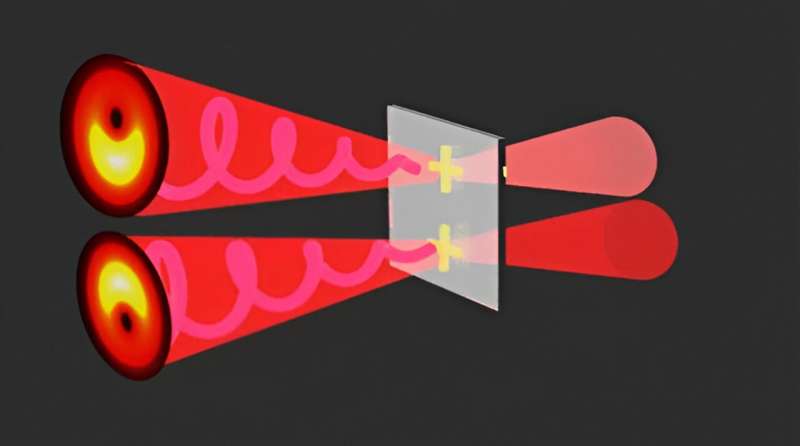
September 30, 2024 by Bernard Rizk, University of Ottawa
Collected at: https://phys.org/news/2024-09-scientists-uncover-absorbing-properties-achiral.html
Researchers at the University of Ottawa have made a discovery that changes what we know about light and materials. They found that engineered achiral (symmetric) materials, called achiral plasmonic metasurfaces, can absorb light differently depending on the handedness of the wavefront of light. This was surprising because, for years, such materials were found to be indifferent to any optical probes and do not show such selective absorption.
The research, conducted over the past year at uOttawa’s Advanced Research Complex (ARC), was led by Ravi Bhardwaj, Professor, Department of Physics at the University of Ottawa and Ph.D. student Ashish Jain.
Collaborators include Howard Northfield, Research Engineer, and colleagues Ebrahim Karimi, Canada Research Chair in Structured Light and Associate Professor of Physics, and Pierre Berini, University Research Chair in Surface Plasmon Photonics and Professor of Electrical Engineering.
The team used a special light tool developed by Professor Karimi’s Structural Quantum Optics (SQO) group and fabricated the necessary structures with the help of Howard Northfield and Professor Berini. Their findings showed that this selective absorption happens because of interactions between different parts of the light and the material.
The research is published in the journal ACS Nano.
“For decades, we believed that these materials couldn’t show any difference in how they absorb polarized light,” says Professor Bhardwaj. “But our research shows that by using a special kind of twisted light, we can control and tune this absorption up to 50%.”
Key points from the study include:
- Breaking the Old Belief: The team showed that achiral structures can indeed absorb light differently, challenging old beliefs.
- Precise Control: They found ways to precisely control this absorption, which could be useful in technologies like optical switches.
- Improved Efficiency: Their special twisted light improved light absorption efficiency in these materials.
- Easier Fabrication: Achiral structures are simpler to make, which could lead to better and more functional optical devices.
- New Insights: The research provides a better understanding of how light interacts with these materials.
Professor Bhardwaj explains, “Our research not only debunks the myth that dichroism doesn’t exist in achiral structures but also opens doors to next-generation plasmonic-based spectroscopy and sensing via enhanced optical metrology.” This work promises significant advancements in optical devices, such as sensors and switches.
In addition, “this discovery is important because it shows that even symmetrical materials can have special light-absorbing properties, opening up new possibilities for advanced sensing and measurement technologies,” adds Jain.
More information: Ashish Jain et al, Selective and Tunable Absorption of Twisted Light in Achiral and Chiral Plasmonic Metasurfaces, ACS Nano (2024). DOI: 10.1021/acsnano.4c06983
Journal information: ACS Nano

Leave a Reply